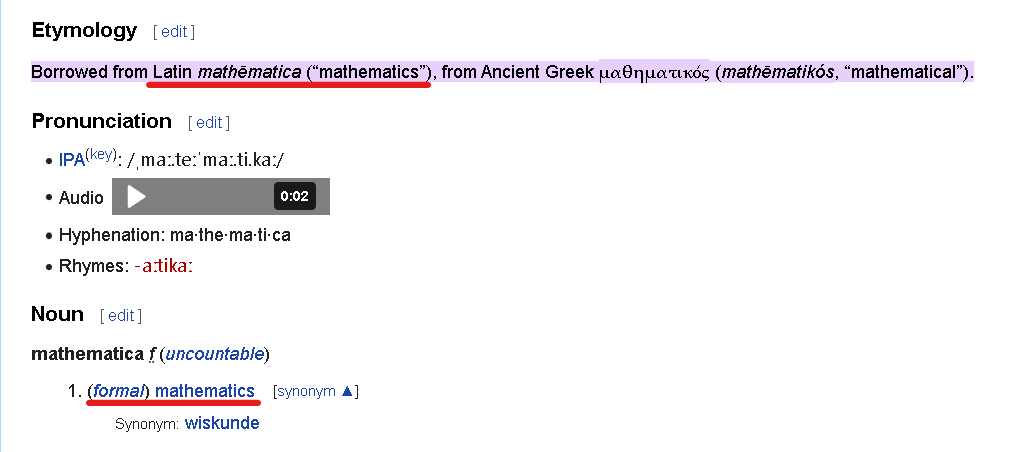watches the people with basic math skills fight to the death over the answer
If you really wanna see a bloodbath, watch this:
You know that a couple has two children. You go to the couple’s house and one of their children, a young boy, opens the door. What is the probability that the couple’s other child is a girl?
50%, since the coins are independent, right?
Oops, I changed it to a more unintuitive one right after you replied! In my original comment, I said “you flip two coins, and you only know that at least one of them landed on heads. What is the probability that both landed on heads?”
And… No! Conditional probability strikes again! When you flipped those coins, the four possible outcomes were TT, TH, HT, HH
When you found out that at least one coin landed on heads, all you did was rule out TT. Now the possibilities are HT, TH, and HH. There’s actually only a 1/3 chance that both are heads! If I had specified that one particular coin landed on heads, then it would be 50%
No. It’s still 50-50. Observing doesn’t change probabilities (except maybe in quantum lol). This isn’t like the Monty Hall where you make a choice.
The problem is that you stopped your probably tree too early. There is the chance that the first kid is a boy, the chance the second kid is a boy, AND the chance that the first kid answered the door. Here is the full tree, the gender of the first kid, the gender of the second and which child opened the door, last we see if your observation (boy at the door) excludes that scenario.
1 2 D E
B B 1 N
B G 1 N
G B 1 Y
G G 1 Y
B B 2 N
B G 2 Y
G B 2 N
G G 2 Y
You can see that of the scenarios that are not excluded there are two where the other child is a boy and two there the other child is a girl. 50-50. Observing doesn’t affect probabilities of events because your have to include the odds that you observe what you observed.
I don’t understand why people say Maths. Math encompasses every single type of Math. Maths is just wrong.
It’s a shortened form of mathematics, build a bridge and get over it
Ok, but the British also shortened television and made it tele. That makes sense because they took part of the word to do it. If you were going to shorten the word mathematics, why wouldn’t it be math, especially when that would follow what you did with television. Why shorten the word and then add the s from the end for no reason?
why wouldn’t it be math, especially when that would follow what you did with television
Because television is singular (a TV set) and Maths is plural, same as Bros. is the abbreviation of brothers. i.e. when abbreviating a plural you keep the “s”.
Because it’s British English
That may be, but Math still encompasses all Math so there’s no need to pluralize it.
The discipline is “mathematics.” It’s really not unreasonable that in some parts of the world, it got shortened to maths.
And the other error present is the incorrect pluralisation. Mathematica means the entire area or domain of knowledge, while mathematics sounds like several lines of thinking, which is weird when we use it as a singular. Maths doesn’t refer to several kinds of math, and that’s confusing.
Mathematica

Maths doesn’t refer to several kinds of math
It refers to all branches of Mathematics.
That’s an after the fact justification.
That’s an after the fact justification
You got some sources with dates in them to show it was “after”, and not, you know, before?
There’s quite a few calculators that get this wrong. In college, I found out that Casio calculators do things the right way, are affordable, and readily available. I stuck with it through the rest of my classes.
My Casio calculators get this wrong, even the newer ones. BTW the correct answer is 16, right?
Yes
8 / 2 (2+2)
8 / 2 (4)
4 (4)
16
No
8 / 2 (2+2)
8 / 2 (4)
8 / 8
1
No. Order of operations is left to right, not right to left. 1 is wrong.
Pemdas.
Multiplication comes before division.
1 is the correct answer.
That’s wrong. Multiplication and division have equal precedence, same as addition and subtraction. You do them left to right. PEMDAS could be rewritten like PE(MD)(AS). After parentheses and exponents, it"s Multiplication and division together, then addition and subtraction together. They also teach BODMAS some places, which is “brackets, order, division and multiplication, addition and subtraction” Despite reversing the division and multiplication, it doesn’t change the order of operations. They have the same priority, so they are just done left to right. PEMDAS and BODMAS are the different shorthand for the same order of operations.
They were right but for the wrong reason. Implied multiplication–that is, a(b) or ab–often comes before explicit multiplication and division. Apparently it’s up to the person writing the equation, so the meme is intentionally and explicitly ambiguous
Different compilers have robbed me of all trust in order-of-operations. If there’s any possibility of ambiguity - it’s going in parentheses. If something’s fucky and I can’t tell where, well, better parenthesize my equations, just in case.
This is best practice since there is no standard order of operations across languages. It’s an easy place for bugs to sneak in, and it takes a non-insignificant amount of time to debug.
there is no standard order of operations across languages
Yes there is. The rules of Maths are universal.
It’s an easy place for bugs to sneak in
But that’s because of programmers not checking the rules of Maths first.
This is the way. It’s an intentionally ambiguously written problem to cause this issue depending on how and where you learned order of operations to cause a fight.
intentionally ambiguously written
#MathsIsNeverAmbiguous
learned order of operations to cause a fight
The order of operations are the same everywhere. The fights arise from people who don’t remember them.
Please see this section of Wikipedia on the order of operations.
The “math” itself might not be ambiguous, but how we write it down absolutely can be. This is why you don’t see actual mathematicians arguing over which one of these calculators is correct - it is not either calculator being wrong, it is a poorly constructed equation.
As for order of operations, they are “meant to be” the same everywhere, but they are taught differently. US - PEMDAS vs UK - BODMAS (notice division and multiplication swapped places). Now, they will say they are both given equal priority, but you can’t actually do all of the multiplication and division at one time. Some are taught to simply work left to right, while others are taught to do multiplication first; but we are all taught to use parentheses correctly to eliminate ambiguity.
Please see this section of Wikipedia on the order of operations
That section is about multiplication, and there isn’t any multiplication in this expression.
The “math” itself might not be ambiguous, but how we write it down absolutely can be
Not in this case it isn’t. It has been written in a way which obeys all the rules of Maths.
This is why you don’t see actual mathematicians arguing over which one of these calculators is correct
But I do! I see University lecturers - who have forgotten their high school Maths rules (which is where this topic is taught) - arguing about it.
it is not either calculator being wrong
Yes, it is. The app written by the programmer is ignoring The Distributive Law (most likely because the programmer has forgotten it and not bothered to check his Maths is correct first).
US - PEMDAS vs UK - BODMAS
Those aren’t the rules. They are mnemonics to help you remember the rules
notice division and multiplication swapped places
Yes, that’s right, because they have equal precedence and it literally doesn’t matter which way around you do them.
you can’t actually do all of the multiplication and division at one time
Yes, you can!
Some are taught to simply work left to right
Yes, that’s because that’s the easy way to obey the actual rule of Left associativity.
we are all taught to use parentheses correctly to eliminate ambiguity
Correct! So 2(2+2) unambiguously has to be done before the division.
Just out of curiosity, what is the first 2 doing in “2(2+2)”…? What are you doing with it? Possibly multiplying it with something else?
there isn’t any multiplication in this expression.
Interesting.
I really hope you aren’t actually a math teacher, because I feel bad for your students being taught so poorly by someone that barely has a middle school understanding of math. And for the record, I doubt anyone is going to accept links to your blog as proof that you are correct.
Just out of curiosity, what is the first 2 doing in “2(2+2)”…? What are you doing with it? Possibly multiplying it with something else?
Distributing it, as per The Distributive Law. Even Khan Academy makes sure to not call it “multiplication”, because that refers literally to multiplication signs., which, as I said, there aren’t any in this expression - only brackets and division (and addition within the brackets).

I feel bad for your students
My students are doing well thanks.

I doubt anyone is going to accept links to your blog as proof that you are correct
You mean the blog that has Maths text book references, historical Maths documents, and proofs? You know proofs are always true, right? But thanks for the ad hominem anyway, instead of any actual proof or evidence to support your own claims.
People in this thread need to watch this: https://youtu.be/lLCDca6dYpA
People in this thread need to watch this: https://youtu.be/lLCDca6dYpA
Debunked here. She managed to never once refer to an actual Maths textbook! Spoiler alert: everyone who has claimed it’s “ambiguous” has done the same thing - no references to any Maths textbooks.
If you think I’m navigating that mess of cross linked posts, well, you’re in for a surprise.
You’re really late to this thread.
She didn’t reference any math textbooks because she made the video for commoners, aka not math majors. Her explanations make sense even if they’re technically wrong from the perspective of pure mathematics.
Unfortunately, I don’t think many people are going to see your reply, and fewer still will deal with the format you’ve chosen to present it in; an even smaller subset will likely understand the concepts you’re trying to explain.
Unfortunately, posting this, so long after the thread was active, linking to your own social media as a reference, seems a lot more like attention seeking behavior. The kind of thing I would expect from a bot or phishing attack, especially since you seem to have copy/pasted the reply on several comments. It’s like you searched for the YouTube link and just vomitted the same reply on every reference to it. That’s bot behavior.
I’m not saying you’re actually a bot, or that anything you’ve posted is incorrect at all. It just seems suspect.
you’re in for a surprise
I’m not actually. A lot of people don’t want to confront evidence that they’re wrong.
She didn’t reference any math textbooks because she made the video for commoners, aka not math majors.
Did you notice she’s a Physics major? In other words, she doesn’t have any Maths textbooks to reference.
Her explanations make sense
So, even when she couldn’t explain why one calculator “sometimes obeys juxtaposition, sometimes doesn’t”, that still made sense to you?
technically wrong
Bingo!
I don’t think many people are going to see your reply
These comments are going to show up in search results for the rest of eternity, so I’m quite happy to debunk the disinformation in it.
you seem to have copy/pasted the reply on several comments
3 different people referred to the same video, so yeah I did something I don’t normally do and copy/pasted for those 3 people. Read my other replies and you’ll find they’re all specific to the person I’m replying to.
It’s like you searched for the YouTube link
No, I’ve had multiple people tell me about it previously, as “proof” that Maths is ambiguous, hence why I wrote a thread debunking the claims she (and others) made.
It just seems suspect
It’s all legit, so feel free to go back and read what I’ve written given that context.
Ah damn it. It took me ages to find a calculator app that fits my needs… And now I find out it works like the one on the right.
… the one on the right is correct… that’s a jank ass calculator on the left that doesn’t know how to do order of operations 8/2×(2+2) 8/2x4 4x4 16
the one on the right is correct
No, it isn’t.
8/2×(2+2)
…isn’t the same thing as 8/2(2+2). You separated the term in the denominator, leading the (2+2) to get flipped into the numerator, hence wrong answer.
That would be 8/(2x(2+2)) if we were keeping it all in the denominator. Multiplication happens in the numerator if there are no parenthesis to distinguish it. If thr equation was written like this:
8
2x(2+2)
Then you would also be correct, but I have to respectfully disagree with your analysis.
That would be 8/(2x(2+2)) if we were keeping it all in the denominator
(2x(2+2)) is the same thing as 2(2+2)
I have to respectfully disagree with your analysis
Which means you disagree with how Maths textbooks teach how to do this (see previous link).
I treat • and × differently, • I treat like the left side and × I treat like the right side calculation.
I treat • and × differently, • I treat like the left side and × I treat like the right side calculation
They literally mean the same thing - just one is used in some countries and the other is used in other countries.
Yes they both are multiply, but…
Calculate 8 ÷ 2a where a = 4. Then,
Calculate 8 ÷ 2 × a where a = 4.
See how in the first form a is implied to be part of the fraction where in the second it isn’t?
A dot • could be between 2 and a and it would still follow the first example. In vector multiplication, dot and cross products produce different results.
Calculate 8 ÷ 2a where a = 4. Then,
Calculate 8 ÷ 2 × a where a = 4.
See how in the first form a is implied to be part of the fraction where in the second it isn’t?
It’s not implied, it’s explicitly because of the definition of Terms.
P.S. now substitute a=2 and you’ll see why it matters.
A dot • could be between 2 and a and it would still follow the first example
No, it wouldn’t. Inserting a dot (multiplication) makes it the same as your second example. i.e. 3 Terms, not 2 Terms.
In vector multiplication, dot and cross products produce different results.
This isn’t vector multiplication. This is Year 7 algebra.
We agree that the two situations are separate. You can call them terms or whatever, since we’re multiplying and dividing the idea of terms seems irrelevant here to me but I suppose for pedantry’s sake we can entertain it. It doesn’t matter what a is, but the first result is 4 ÷ a the second result is 4a.
I use the dot as an expression of the same term rather than separate. This is matter of my notational convention, due to dot multiplication providing a single scalar result where cross multiplication resulting in a vector product. You can write 10 paragraphs telling me that my convention is wrong and why but I don’t really care that much, to save you some time.
ETA: When I handwrite out non-Vector equations, you will rarely see me write a • or a × sign inside of a fraction anyway, it’s placement is generally clear enough for me, and I will put brackets where it’s confusing.
We agree that the two situations are separate
Ok, that’s a start.
but the first result is 4 ÷ a the second result is 4a
Exactly! So when a=2 then 4÷a=2, and 4a=8, which isn’t the same thing. Welcome to why 2a and 2xa (and therefore also 2.a) aren’t the same thing.
I use the dot as an expression of the same term rather than separate.
But that is incorrect. A dot is used for multiplication. i.e. it separates terms. If you use a . for 2.a, then you are writing the same thing as 2xa, not the same thing as 2a.
This is matter of my notational convention
Well, that’s fine enough if you keep it to yourself, but don’t use it in anything anyone else is going to read, or you’re going to run into the issues I just pointed out
In some countries we’re taught to treat implicit multiplications as a block, as if it was surrounded by parenthesis. Not sure what exactly this convention is called, but afaic this shit was never ambiguous here. It is a convention thing, there is no right or wrong as the convention needs to be given first. It is like arguing the spelling of color vs colour.
BDMAS bracket - divide - multiply - add - subtract
BEDMAS: Bracket - Exponent - Divide - Multiply - Add - Subtract
PEMDAS: Parenthesis - Exponent - Multiply - Divide - Add - Subtract
Firstly, don’t forget exponents come before multiply/divide. More importantly, neither defines wether implied multiplication is a multiply/divide operation or a bracketed operation.
Exponents should be the first thing right? Or are we talking the brackets in exponents…
Brackets are ALWAYS first.
I don’t think you encounter this one very often, but the technically correct
-2^2 = -4has a higher chance of ruining your day.You mean x^2 =4 where x=±2
No, you’d expect that -2^2 would equal 4, but calculators solve it as -(2)^2 not (-2)^2. But the case you mentioned is also pretty common.
if you’ve touched polynomials ever, you’d expect the exponent to be before the negation. If you write x³-x² you don’t mean x³ + (-x)² = x³+x², you mean x³-(x²)
People keep debating over this stuff. I have a simpler solution. Math is not real.
My mom’s a mathematician, she got annoyed when I said that the order of operations is just arbitrary rules made up by people a couple thousand years ago
My mom’s a mathematician, she got annoyed when I said that the order of operations is just arbitrary rules made up by people a couple thousand years ago
I’m not surprised. Here’s the proof of the order of operations rules. Also, the equals sign wasn’t invented until the 16th century, so only 500 years old at most (the earliest references to order of operations are over 400 years ago).
That proof for the order of operations sure seems to rely a lot on our current order of operations…
That proof for the order of operations sure seems to rely a lot on our current order of operations
Doesn’t use order of operations at all. It only uses the definitions of the operators. i.e. 3x4=3+3+3+3 by definition. i.e. nothing to do with order of operations.
If I have 1 2l bottle of milk, and 4 3l bottles of milk, how many litres of milk do I have? It can be solved by simply adding them up - again, nothing to do with order of operations here, just simple addition. Now, write it out as a mathematical expression which uses multiplication, and tell me which order of operations gets you the right answer. Voila! Welcome to how we worked out what the order of operations rules had to be.
2+(4x3) gives the right answer, with addition coming before multiplication
2+(4x3) gives the right answer, with addition coming before multiplication
If we rewrote all of Maths so that addition came before multiplication, then no, 2+3x4 would no longer mean what it does now (because + and x would have to mean something different to what they do now in order for the order to be swapped). The order of operations rules come directly from the definitions. You can’t just say “we’ll do addition first” without having defined what addition is now, nor multiplication. In a world where addition comes before multiplication, that means multiplication is no longer shorthand for addition (because that’s the very thing which means we have to do multiplication before addition, so it can’t be true anymore if now we’re doing addition first).
Let’s take an imaginary scenario where we now use x for add, and + for multiply. That would indeed mean that + has to be done before x, but note that + now means multiply. That means your “addition first” 2+(3x4) is what we currently mean by 2x(3+4) which is 14. Now take away the brackets (since I don’t use brackets when adding up the milk! Just 2+3x4). Your addition-first 2+3x4 is equivalent in our multiplication-first world to 2x3+4 which equals 10 - the wrong answer! So now you’ve created a world where we have to add brackets to things just to get the right answer! Why would you even want to do that when it works the way it is? The whole point to having order of operations rules is to not have to add brackets!
It’s organized so that more powerful operations get precedence, which seems natural.
Set aside intentionally confusing expressions. The basic idea of the Order of Operations holds water even without ever formally learning the rules.
If an addition result comes first and gets exponentiated, the changes from the addition are exaggerated. It makes addition more powerful than it should be. The big stuff should happen first, then the more granular operations. Of course, there are specific cases where we need to reorder, or add clarity, which is why human decisions about groupings are at the top.
The big stuff should happen first, then the more granular operations
The “big stuff” is stuff that is defined in terms of something else. i.e. exponents are shorthand for repeated multiplication… and multiplication is shorthand for repeated addition, hence they have to be done in that order or you get wrong answers.
“Wrong answers” only according to our current order of operations, math still works if you, for example, make additions come first (as long as you’re consistent about it).
OFC it is a convention and to change it you would have to change all expressions ever written all at the same time, to avoid confusion between competing standards. I’m not arguing that it should be changed, only that there is no ‘high truth’ behind it.
“Wrong answers” only according to our current order of operations
No, according to arithmetic.
math still works if you, for example, make additions come first
No, it doesn’t - order of operations proof. The only way it could work with addition first is if we swapped the definitions of addition and multiplication around… but then we still have the same order of operations, all we’ve done is swapped around what we call addition and multiplication!
there is no ‘high truth’ behind it.
There is when it comes to order of operations.
Let’s assume for a minute addition comes first. We know 2+3 is 5, and 5x4 is the same as 5+5+5+5=20. What is the issue with that?
5+5+5+5=20. What is the issue with that?
That it’s wrong. If I have 1 2 litre bottle of milk, and 4 3 litre bottles of milk - i.e. 2+3x4 - how many litres of milk do I have? Without even doing the arithmetic, just count it up and tell me how many litres there is.
I’m with the right answer here. / and * have same precedence and if you wanted to treat
2(2+2)as a single unit, you should have written it like(2*(2+2)).It’s pretty common even in academic literature to treat implied multiplication as having higher precedence than explicit multiplication/division. Otherwise an expression like 1 / 2n would have to be interpreted as (1 / 2) * n rather than the more natural 1 / (2 * n).
A lot of this bullshit can be avoided with better notation systems, but calculators tend to be limited in what you can write, so meh. Unless you want to mislead people for the memes, just put parentheses around things.
The problem is whether or not that rule is taught depends on when and where you learned it. Schools only started teaching that rule relatively recently, and even then, not universally. Which of course makes for ideal engagement bait on your hellsite of choice.
Schools only started teaching that rule relatively recently
Recently? The order of operations rules have been taught for more than a century (we can see them in Lennes’ letter).
Order of operations in general, yes. Implied multiplication coming before explicit multiplication/division is what’s recent.
Implied multiplication coming before explicit multiplication/division is what’s recent.
- “implicit multiplication” is not taught, because there’s no such thing as implicit multiplication
- the “controversy” over it isn’t recent either - we can see Lennes complaining about it more than 100 years ago! The more things change the more they stay the same (sigh).
this comment section illustrates perfectly why i hate maths so much lmao
love ambiguous, confusing rules nobody can even agree on!
lol, math is literally the only subject that has rules set in stone. This example is specifically made to cause confusion. Division has the same priority as multiplication. You go from left to right. problem here is the fact that you see divison in fraction form way more commonly. A fraction could be writen up as (x)/(y) not x/y (assuming x and y are multiple steps). Plain and simple.
The fact that some calculator get it wrong means that the calculator is wrongly configured. The fact that some people argue that you do () first and then do what’s outside it means that said people are dumb.
They managed to get me once too, by everyone spreading missinformation so confidently. Don’t even trust me, look up the facts for yourself. And realise that your comment is just as incorrect as everyone who said the answer is 1. (uhm well they don’t agree on 0^0, but that’s kind of a paradox)
math is literally the only subject that has rules set in stone
Indeed, it does.
This example is specifically made to cause confusion.
No, it isn’t. It simply tests who has remembered all the rules of Maths and who hasn’t.
Division has the same priority as multiplication
And there’s no multiplication here - only brackets and division (and addition within the brackets).
A fraction could be writen up as (x)/(y) not x/y
Neither of those. A fraction could only be written inline as (x/y) - both of the things you wrote are 2 terms, not one. i.e. brackets needed to make them 1 term.
The fact that some people argue that you do () first and then do what’s outside it means that
…they know all the relevant rules of Maths
look up the facts for yourself
You can find them here
your comment is just as incorrect as everyone who said the answer is 1
and 1 is 100% correct.
well they don’t agree on 0^0
Yes they do - it’s 1 (it’s the 5th index law). You might be thinking of 0/0, which depends on the context (you need to look at limits).
are you drunk?
Knowing the rules of Maths means someone might be drunk? Interesting conclusion.
Fuck it, I’m gonna waste time on a troll on the internet who’s necroposting in te hopes that they actually wanna argue the learning way.
This example is specifically made to cause confusion.
No, it isn’t. It simply tests who has remembered all the rules of Maths and who hasn’t.
I said this because of the confusion around the division sign. Almost everyone at some point got it confused, or is just hell bent that one is corrent the other is not. In reality, it is such a common “mistake” that ppl started using it. I’m talking about the classic
4/2x. Ifx = 2, it is:4/2*2 = 2*2 = 44/(2*2) = 4/4 = 1
Wolfram solved this with going with the second if it is an X or another variable as it’s more intuitive.
Division has the same priority as multiplication
And there’s no multiplication here - only brackets and division (and addition within the brackets).
Are you sure ur not a troll? how do you calculate
2(1+1)? It’s4. It’s called implicit multiplication and we do it all the time. It’s the same logic that if a number doesn’t have a sign it’s positive. We could write this up as+2*(+1+(+1)), but it’s harder to read, so we don’t.A fraction could be writen up as (x)/(y) not x/y
Neither of those. A fraction could only be written inline as (x/y) - both of the things you wrote are 2 terms, not one. i.e. brackets needed to make them 1 term.
I don’t even fully understand you here. If we have a faction; at the top we have
1+2and at the bottom we have6-3. inline we could write this as(1+2)/(6-3). The result is 1 as if we simplify it’s3/3.You can’t say it’s
((1+2)/(6-3)). It’s the same thing. You will do the orders differently, but I can’t think of a situation where it’s incorrect, you are just making things harder on yourself.The fact that some people argue that you do () first and then do what’s outside it means that
…they know all the relevant rules of Maths
You fell into the 2nd trap too. If there is a letter or number or anything next to a bracket, it’s multiplication. We just don’t write it out, as why would we, to make it less readable?
2xis the same as2and that’s the same as2(x).look up the facts for yourself
You can find them here
I can’t even, you linked social media. The #1 most trust worthy website. Also I can’t even read this shit. This guy talks in hashtags. I won’t waste energy filtering out all the bullshit to know if they are right or wrong. Don’t trust social media. Grab a calculator, look at wolfram docs, ask a professor or teacher. Don’t even trust me!
your comment is just as incorrect as everyone who said the answer is 1
and 1 is 100% correct.
I chose a side. But that side it the more RAW solution imo. let’s walk it thru:
8/2(2+2), let’s remove the confusion8/2*(2+2), brackets8/2*(4), mult & div, left -> right4*(4), let go4*4, the only16, answer
BUT, and as I stated above IF it’d be like:
8/2xwithx=2+2then, we kinda decided to put implicit brackets there so it’s more like8/(2x), but it’s just harder to read, so we don’t.And here is the controversy, we are playing the same game. Because there wasn’t a an explicit multilication, you could argue that it should be handled like the scenario with the x. I disagree, you agree. But even this argument of “like the scenario with the x” is based of what Wolfram decided, there are no rules of this, you do what is more logical in this scenario. It can be a flaw in math, but it never comes up, as you use fractions instead of inline division. And when you are converting to inline, you don’t spear the brackets.
well they don’t agree on 0^0
Yes they do - it’s 1 (it’s the 5th index law). You might be thinking of 0/0, which depends on the context (you need to look at limits).
You said it yourself, if we
lim (x->0) y/xthen there is an answer. But we aren’t in limits.x/0in undefined at all circumstances (I should add that idk abstract algebra & non-linear geometry, idk what happens there. So I might be incorrect here).
And by all means, correct me if I’m wrong. But link something that isn’t an unreadable 3 parted mostodon post like it’s some dumb twitter argument. This is some dumb other platform argument. Or don’t link anything at all, just show me thru, and we know math rules (now a bit better) so it shouldn’t be a problem… as long as we are civilised.
side note: if I did some typos… it’s 2am, sry.
I’m talking about the classic 4/2x. If x = 2, it is:
4/2x2 = 2x2 = 4
4/(2x2) = 4/4 = 1
It’s the latter, as per the definition of Terms. There are references to this definition being used going back more than 100 years.
Wolfram solved this with going with the second if it is an X or another variable as it’s more intuitive
Yes, they do if it’s 2x, but not if it’s 2(2+2) - despite them mathematically being the same thing - leading to wrong answers to expressions such as the OP. In fact, that’s true of every e-calculator I’ve ever seen, except for MathGPT (Desmos used to handle it correctly, but then they made a change to make it easier to enter fractions, and consequently broke evaluating divisions correctly).
how do you calculate 2(1+1)? It’s 4. It’s called implicit multiplication
No, it’s not called implicit multiplication. It’s distribution.
We could write this up as +2*(+1+(+1))
No, you can’t. Adding that multiplication has broken it up into 2 terms. You either need to not add the multiply, or add another set of brackets if you do, to keep it as 1 term.
I can’t think of a situation where it’s incorrect
If a=2 and b=3, then…
1/axb=3/2
1/ab=(1/6)
If there is a letter or number or anything next to a bracket, it’s multiplication
No, it’s distribution. Multiplication refers literally to multiplication signs, of which there aren’t any in this expression.

2x is the same as 2*x
No, 2A is the same as (2xA). i.e. it’s a single Term. 2xA is 2 Terms (multiplied).
If a=2 and b=3, then…
axb=2x3 (2 terms)
ab=6 (1 term)
This guy talks in hashtags.
Only in the first post in each thread, so that people following those hashtags will see the first post, and can then click on it if they want to see the rest of the thread. Also “this guy” is me. :-)
Grab a calculator, look at wolfram docs, ask a professor or teacher
I’m a Maths teacher with a calculator and many textbooks - I’m good. :-) Also, if you’d clicked on the thread you would’ve found textbook references, historical Maths documents, proofs, the works. :-)
8/2(2+2), let’s remove the confusion
8/2*(2+2), brackets
8/2*(4), mult & div, left -> right
4*(4), let go
2 mistakes here. Adding the multiplication sign in the 2nd step has broken up the term in the denominator, thus sending the (2+2) into the numerator, hence the wrong answer (and thus why we have a rule about Terms). Then you did division when there was still unsolved brackets left, thus violating order of operations rules.
it’s more like 8/(2x), but it’s just harder to read, so we don’t
But that’s exactly what we do (but no extra brackets needed around 2x nor 2(2+2) - each is a single term).
you could argue that it should be handled like the scenario with the x
Which is what the rules of Maths tells us to do - treat a single term as a single term. :-)
there are no rules of this
Yeah, there is. :-)
you use fractions instead of inline division
No, never. A fraction is a single term (grouped by a fraction bar) but division is 2 terms (separated by the division operator). Again it’s the definition of Terms.
And by all means, correct me if I’m wrong
Have done, and appreciate the proper conversation (as opposed to those who call me names for simply pointing out the actual rules of Maths).
link something that isn’t an unreadable
No problem. I t doesn’t go into as much detail as the Mastodon thread though, but it’s a shorter read (overall - with the Mastodon thread I can just link to specific parts though, which makes it handier to use for specific points), just covering the main issues.
as long as we are civilised
Thanks, appreciated.
Idk where you teach, but I’m thankful you didn’t teach me.
Let me quizz you, how do you solve
2(2+2)^2? because acording to your linked picture, because brackets are leftmost you do them first. If I were to believe you:(2*2+2*2)^2(4+4)^2, = 64
but it’s just simply incorrect.
2(4)^2, wow we’re at a2x^22*16= 32
The thing that pisses me off most, is the fact that, yes. Terms exists, yes they have all sorts of properties. But they are not rules, they are properties. And they only apply when we have unknows and we’re at the most simplified form. For example your last link, the dude told us that those terms get prio because they are terms!? There are no mention of term prio in the book. It just simply said that when we have a simplified expression like:
2x^2+3x+5we call2x^2and3xand5terms. And yes they get priority, not because we named them those, but because they are multiplications. These help us at functions the most. Where we can assume that the highest power takes the sign at infinity. Maybe if the numbers look right, we can guess where it’d switch sign.I don’t even want to waste energy proofreading this, or telling you the obvious that when we have a div. and a mult. and no x’s there really is no point in using terms, as we just get a single number.
But again, I totally understand why someone would use this, it’s easier. But it’s not the rule still. That’s why at some places this is the default. I forgot the name/keywords but if you read a calculator’s manual there must be a chapter or something regarding this exact issue.
So yeah, use it. It’s good. Especially if you teach physics. But please don’t go around making up rules.
As for your sources, you still linked a blog post.
This is more language/writing style than math. The math is consistent, what’s inconsistent is there are different ways to express math, some of which, quite frankly, are just worse at communicating the mathematical expression clearly than others.
Personally, since doing college math classes, I don’t think I’d ever willingly write an expression like that exactly because it causes confusion. Not the biggest issue for a simple problem, much bigger issue if you’re solving something bigger and need combine a lot of expressions. Just use parentheses and implicit multiplication and division. It’s a lot clearer and easier to work with.
implicit multiplication
Something about the way this thread was written was kind of confusing, so I don’t really get what their point was. Is it just that the terminology is wrong? Or am I missing something?
Like, whatever you call it, a x b, a*b, ab, and a(b) are all acceptable notations to describe the operation “multiply a and b.” Some are nicer to use than others depending on the situation.
Something about the way this thread was written was kind of confusing,
Ok, sorry about that. I’m more than happy to update it if you want to give me some constructive feedback on what was confusing about it. Note though that this was the 3rd part in the series, and maybe you didn’t go back and read the previous 2 parts? They start here
Is it just that the terminology is wrong? Or am I missing something?
Yes and yes. :-) The 2 actual rules of Maths that apply here are Terms and The Distributive Law. These are 2 different rules of Maths - neither of which is “multiplication” - and so when lumping them together as “implicit multiplication” you end up with unpredictable, and usually wrong, answers. The only way to always get the right answer is to follow the actual rules of Maths.
a x b, a*b, ab, and a(b) are all acceptable notations to describe the operation “multiply a and b.”
No, they’re not. The first two are multiplications, the second two are Terms. Note that a Term is a product, the result of a multiplication. In the mnemonics, “Multiplication”" refers literally to multiplication signs, and nothing else.
Ok, sorry about that. I’m more than happy to update it if you want to give me some constructive feedback on what was confusing about it. Note though that this was the 3rd part in the series, and maybe you didn’t go back and read the previous 2 parts? They start here
NP. I’m not really great at giving writing advice, so can’t really help there. Something about it just didn’t click when I read it. The extra context you linked did help a bit.
As far as the issue: After reading it I think it does just seem to be a matter of terminology mixed with problems that arise with when you need to write math expressions inline in text. If you can write things out on paper or use a markdown language, it’s really easy to see how a fractional expression is structured.
8
2(1+3)
is a lot easier to read than 8/2(1+3) even if they technically are meant to be evaluated the same. There’s no room for confusion.
And as for distributive law vs multiplication, maybe this is just taking for granted a thing that I learned a long time ago, but to me they’re just the same thing in practice. When I see a(x+1) I know that in order to multiply these I need to distribute. And if we fill in the algebraic symbols for numbers, you don’t even need to distribute to get the answer since you can just evaluate the parentheses then use the result to multiply by the outside.
Conversely, if I was factoring something, I would need to do division.
ax + a
a
= x+1, thus: a(x+1)
I think we’re basically talking about the same thing, I’m just being a bit lose with the terminology.
And while we’re at it, the best way to make sure there’s no misunderstanding is to just use parenthesis for EVERYTHING! I’m mostly kidding, this can rapidly get unreadable once you nest more than a few parens, although for these toy expressions, it would have the desired effect.
(8)/(2(1+3)) is obviously different than (8/2)(1+3)
8/2(1+3) even if they technically are meant to be evaluated the same
But 8/2(1+3) isn’t a fraction. The / - the computing equivalent of ÷ (which can only be written using Unicode on a computer, so a bit of a pain to use compared to / )- is an operator, which means they’re 2 separate terms. A fraction bar is a grouping symbol, which means it’s 1 term. In this particular case it doesn’t matter, but if it appeared in a bigger expression then it absolutely does matter. The way to write 8/2(1+3) as a fraction inline is to add extra brackets. i.e. (8/2(1+3)) - because brackets are also a grouping symbol.
And as for distributive law vs multiplication, maybe this is just taking for granted a thing that I learned a long time ago, but to me they’re just the same thing in practice
Bu they’re not, for the same reason. Firstly, the Distributive Law isn’t multiplication at all - which only applies literally to multiplication symbols - it applies to bracketed terms (i.e. is a single term which needs to be distributed) - and secondly it applies to a single term, whereas multiplication applies to 2 terms (one before and one after). Anyone who talks about 2(1+3) needing to be “multiplied” has already made the mistake that is going to lead to a wrong answer (unless they just happen to “multiply” before they divide, which is an accidental way to get the right answer).
if I was factoring something
Indeed, that is the precise reason the Distributive Law exists - they are the opposite operation to each other! Anyone who adds a multiplication symbol has broken up the factorised term, again leading to the wrong answer.
I’m just being a bit lose with the terminology
Yeah, and that’s all I was pointing out in the first place - please don’t use “implicit multiplication”. The term itself - i.e. it includes “multiplication” - leads people to do it wrong (because they treat it as multiplication, not brackets, then argue about the precedence of “multiplication”!). It needs to die!
this can rapidly get unreadable once you nest more than a few parens,
Well that’s why the rules of Terms ab=(axb) and The Distributive Law a(b+c)=(a*(b+c))=(ab+ac) exist to begin with - less brackets! :-) Imagine having to write a fraction as (1/(axb)) all the time!
(8)/(2(1+3)) is obviously different than (8/2)(1+3)
Correct, though a lot of people treat it as the latter (yet another way to do it wrong - doing division before brackets) because they figure the 8/2 is “outside the brackets”, but in fact only the 2 is, because the slash separates them as being 2 terms.












